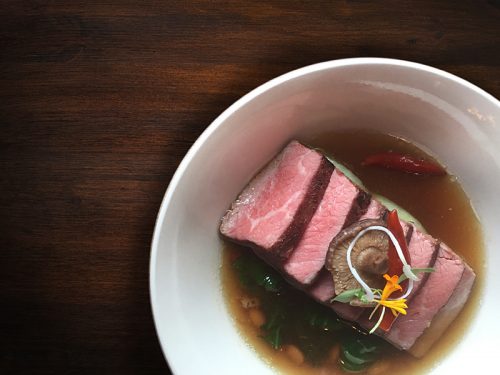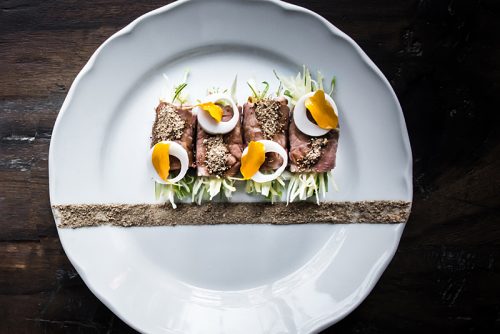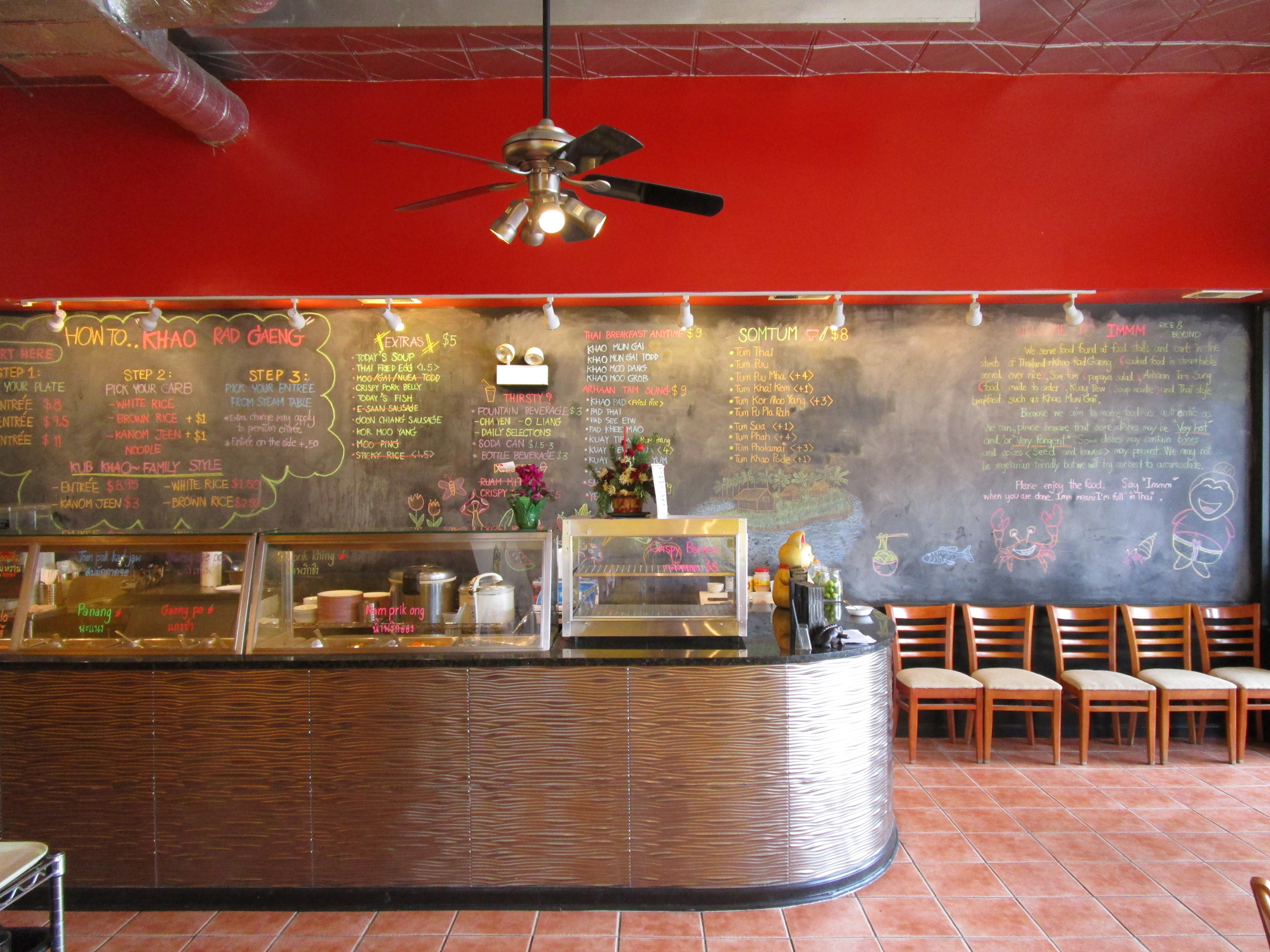STREET FOOD IS THE STANDARD OF authenticity by which, for better or worse, food is judged to be worthy of attention. Many new Thai restaurants aspire to serve the food of street vendors—Immm Rice and Beyond (4949 N. Broadway), Four Belly (3227 N. Clark), and, most obviously, JJ Thai Street Food (1715 W. Chicago), all want you to believe that what you’re eating in their dining rooms is what Thai folks eat on the streets of Bangkok and Chiang Mai. But there’s more than one definition of “authentic” as it applies to Thai and other culinary traditions.

Dining room with mural of King Bumibol
At NaKorn, a new and mid-upscale Thai restaurant in Evanston, co-owners Sam Rattanopas and Mina Sudsaard are making the kind of Thai you probably don’t know, the kind of Thai that these two friends once enjoyed at their family homes in Thailand. They did not, however, come to the U.S. to serve that food, or any food. At least not at first:

MIna Sudsaard, Sam Rattanopas, owners
MINA: Life in Thailand was great! There are a lot of places to go and see. Out with friends, no stress. But I kind of wanted to spread my wings. So, after I finished undergrad in Thailand, I wanted to come here for an American education in design. The original plan was to come just for school, but I fell in love with an American and stayed.
SAM: Life in Thailand was fun, crazy and happy. There was always plenty of good food everywhere and at any time of day. I miss that. At the same time, city life in Bangkok can be hectic and stressful. It’s my hometown, but the traffic, noise, dirt and heat can be overwhelming.
Mina went to Columbia College for her 2nd BA in Computer Graphic Design, and I went to De Paul for an MS in Telecommunications. A year after we got here, though, we both knew we loved it and wanted to live our lives here. Funny to say, we think life is much simpler in the States than in Thailand, particularly Bangkok. To us, life in Evanston and Chicago is peaceful, a big city with a sense of small town community. I’ve come to think this even more in the past few months, since the people of Evanston have been incredibly welcoming and friendly.
I think a lot of Thai restaurants just focus on “sweet” and “hot.” Yet, there are five essential taste sensations in Thai food—not only sweet and hot, but also sour, bitter and salt.
For foodies in search of authenticity, much about NaKorn, from the location (a suburb) and the handsome decor to the relatively upscale entrees and elevated price points (entrees in the $20s), will set off warning bells of compromise, fusion food, Americanization—the fear that it’s not the real thing, like you’d find in a hole in a wall restaurant in an ethnic enclave.
Yet when Rattanopas and Sudsaard started exploring the culinary options in Chicago, they were disappointed with many of the Thai restaurants they visited. What they were served was not what they were used to eating at home—it wasn’t, for them, the real thing:
MINA: If you ask me where you can find the greatest Thai food in Thailand, my answer is “Mom!” I wanted to serve here, in Evanston, dishes that we had at home. The food that we ate growing up in Thailand. So, at NaKorn, we’re taking our memories and reinterpreting them in a modern way.
SAM: We believe that authentic Thai food should not be found only in Thailand. What started us thinking along this path was our inability to get what we wanted to eat, anywhere in Chicagoland. We wanted to show people Thai dishes that we grew up eating and loving, using the finest ingredients and creating a blend of bold flavors with old-world recipes in a modern presentation. To us, the concept involves not just the ingredients and taste, but also intricacy, attention to detail, texture, color, aroma and context. That last point—context—is why we put so much thought and effort into our dining room’s eclectic, old-world ambience and our knowledgeable and friendly staff
Don’t get me wrong: many Thai restaurants in Chicago serve flavorful dishes. It’s just that most of those dishes aren’t really authentic Thai. For the most part, they’re Americanized. I enjoy eating them, but they don’t satisfy my hunger for authentic Thai dishes.
MINA: To me there are two things. First, I think a lot of Thai restaurants just focus on “sweet” and “hot.” Yet, there are five essential taste sensations in Thai food—not only sweet and hot, but also sour, bitter and salt. And an authentic Thai dish will intricately combine at least three of those. Second, a lot of Thai places adapt their ingredients, either because they can’t find what’s used at home in Thailand, or they find it too expensive. For example, cilantro root. Here, everyone cooks with the cilantro leaves, but in Thailand the root is used. You just can’t get the root from commercial sellers here, at any price. So we found a local, organic farmer to grow cilantro for us so that we can get the root for authenticity.

Mina’s braised short ribs
One of the main characteristics of Thai food—in either Thailand or Chicago, usually—is definitely chili heat, the power of the Central American hot pods that revolutionized the cuisines of faraway places like India and much of Southeast Asia. The food at NaKorn, however, seems almost immune to the consequences of the Columbian Exchange; you will find that what you’re eating at NaKorn packs nowhere near the incendiary levels of chili heat you’ll enjoy (or not) at many other Thai restaurants.
SAM: Most Thai people enjoy spicy food, but we also enjoy the other flavor profiles as well. I grew up eating food that has a bit of heat, but it was also important that we could taste the actual food and the other flavors, not just a full-blown heat. Good Thai dishes should have a harmonious finish of multiple tastes.
MINA: I agree. Thai food has proportionate amounts of mixed flavors – no real Thai dish is just spicy or just sweet. We want our customers to taste all the combinations of flavors of Thai food. And this is what our customers seem to comment on the most – their adventure with our dishes as they try to figure out the tastes they’re experiencing! For me, one of the most enjoyable parts of owning NaKorn is visiting with customers as they have that experience.
The balanced approach to the key Thai flavors of sweet, hot, sour, bitter and salt is much more finessed than a lot of the food you’ll find at Thai street markets, which makes sense particularly when you consider that Sam and Mina are likely using higher-quality ingredients than would be available—or affordable—to most Thai street vendors. If you’re paying a lot for good raw materials –meat, fish, herbs, vegetables – you don’t want to lose the nuance.
I asked Sam and Mina about the dishes that they feel are most representative of their interpretations of Thai cuisine.

Khun Sompit’s Big Fish
SAM: Khun Sompit is my father, and our dish—Khun Sompit’s Big Fish—is one of his favorites. Our recipe is just about identical to the one at home, with spices complementing a turmeric base. When I was young my grandma always cooked it for us, and when my dad was young she cooked it for him. It’s a southern Thai dish that I love. It’s pretty hard to find this fish outside of people’s homes, even in Bangkok.
Mina’s Braised Short Ribs were inspired by her mom, who used spare ribs. Again, when coming to a foreign country, you need to use whatever raw ingredients make sense.
MINA: My mom was the one who cooked spare ribs for us. She traveled to Chiang Mai and spent a lot of time there. This dish was originally from there but she changed it to her own style. I remember coming into the house after school, and I could instantly smell it. That memory makes me very happy. We prepare it at NaKorn almost like the way my mom did it – marinate the meat for four hours then slow cook for thirteen. The only thing that we do differently here is that we cook the meat and the soup separately so that we don’t overcook the meat.
I asked them if there was one dish at NaKorn that they considered quintessentially Thai, representing everything they loved about the Thai culinary tradition:
SAM: To me, the quintessential dish represents the five flavors of Thai cooking. That’s why I think our house-made sauces are what really make NaKorn unique. We have a different, house-made sauce for almost every dish—probably two dozen sauces—each made from scratch using fresh ingredients, herbs and spices. It’s a ton of work but sets us apart.
MINA: I agree with Sam. But, if I had to pick one dish on our menu that’s “quintessential” to me, I’d say our house made Pandan Tapioca Pearl Crackers, with tamarind-coconut relish of minced chicken and shrimp. It’s a combination of salty and sweet with a subtle hint of sour. Those are key flavors associated with Thai food.
The night I visited NaKorn, I was told that one table was full of guests—not Thai—from Riverside who travel up to Evanston on a weekly basis to eat at NaKorn. And they’re not coming for pad thai, which is not now nor will likely ever be on the menu, nor are they coming to compete in a sweat-swept bro-down to see who can smash the hottest platter of chili-laced pork into their pie hole. Instead, these repeat customers have apparently found a style of Thai food at NaKorn that they’re not finding at many other local Thai restaurants.

Grilled sliced tenderloin
It’s likely that you’ll find just about every dish on NaKorn’s menu to be both Thai-inspired and yet sometimes almost unrecognizably Thai. There’s a yin-yang situation: the food at NaKorn doesn’t deliver the tongue-tingling capsaicin firecrackers you may be accustomed to at other Thai restaurants, but what that means is that other flavors are not submerged beneath a burning blanket of chili heat. As a consequence, you may actually find yourself enjoying Thai flavors that you may not have noticed before.
Is it more authentic than other Thai restaurants, or less? Ultimately, the question is meaningless; it’s authentic to its owners, Sam and Mina.
David Hammond is the Dining and Drinking editor for Newcity, and a current contributor to the Chicago Tribune, Plate magazine and Oak Park’s Wednesday Journal. He is a founder and moderator of LTHForum.com, wrote hundreds of reviews for the Chicago Reader, Time Out Chicago and others, wrote a weekly “Food Detective” column for the Chicago Sun-Times, and was nominated for a James Beard Foundation award for his Soundbites series for WBEZ.
Latest
Join the Discussion
After you comment, click Post. If you're not already logged in you will be asked to log in or register with Disqus.







